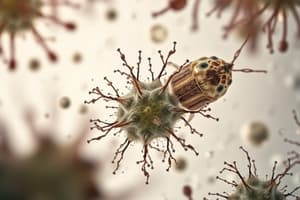Podcast
Questions and Answers
What is the relationship between magnification and resolution in light microscopy?
What is the relationship between magnification and resolution in light microscopy?
- Magnification and resolution are directly proportional, increasing one will automatically increase the other
- Magnification and resolution are inversely proportional, increasing one will decrease the other
- Magnification and resolution are unrelated, changing one will not affect the other
- Magnification can be increased without limit, but resolution cannot be improved beyond a certain point (correct)
What is the role of disinfectants and antiseptics in microbiology?
What is the role of disinfectants and antiseptics in microbiology?
- To identify different types of microorganisms under a microscope
- To increase the resolution of light microscopes
- To eliminate or reduce the number of microorganisms on surfaces and in cultures (correct)
- To promote the growth of microorganisms in cultures
What is the limitation of light microscopy in distinguishing small objects?
What is the limitation of light microscopy in distinguishing small objects?
- It can only distinguish objects larger than the wavelength of light
- It cannot distinguish objects that are smaller than half the wavelength of light (correct)
- It can distinguish objects of any size with the appropriate magnification
- It is limited by the intensity of light used in the microscope
How does electron microscope resolution compare to that of a light microscope?
How does electron microscope resolution compare to that of a light microscope?
Which type of microscopy uses electrons and electromagnets to image cells at a resolving power of 0.2 nm?
Which type of microscopy uses electrons and electromagnets to image cells at a resolving power of 0.2 nm?
What is the resolving power of Electron Microscopy?
What is the resolving power of Electron Microscopy?
What strategies are used in light microscopes to observe living cells?
What strategies are used in light microscopes to observe living cells?
Which of the following is a non-cellular microorganism?
Which of the following is a non-cellular microorganism?
What is a characteristic of Prokaryotic cells?
What is a characteristic of Prokaryotic cells?
In which cellular structure are respiratory enzymes found in Eukaryotic cells?
In which cellular structure are respiratory enzymes found in Eukaryotic cells?
Which type of cells may have flagella or cilia for locomotion?
Which type of cells may have flagella or cilia for locomotion?
Which book covers the observation of microorganisms through a microscope and the functional anatomy of prokaryotic and eukaryotic cells?
Which book covers the observation of microorganisms through a microscope and the functional anatomy of prokaryotic and eukaryotic cells?
What is the magnification capability of Electron Microscopy?
What is the magnification capability of Electron Microscopy?
What is the distinguishing feature of Eukaryotic cell wall composition?
What is the distinguishing feature of Eukaryotic cell wall composition?
What is the distinguishing feature of Prokaryotic cell wall composition?
What is the distinguishing feature of Prokaryotic cell wall composition?
What is a characteristic of Eukaryotic cell division?
What is a characteristic of Eukaryotic cell division?
Flashcards are hidden until you start studying
Study Notes
Microscopy and Microorganism Structures
- Electron Microscopy uses electrons and electromagnets to image cells at a resolving power of 0.2 nm, magnifying objects up to 1 million times.
- There are two types of Electron Microscopy: Scanning Electron Microscopy (SEM) and Transmission Electron Microscopy (TEM).
- Light microscopes allow observation of living cells, using strategies like video cameras and fluorescent dyes for enhanced contrast.
- Microorganisms are classified into Prokaryotic (Bacteria, Archaea), Eukaryotic (Fungi, Protozoa, Algae), and Non-cellular (Viruses, Prions).
- Prokaryotic cells lack a nucleus, have a cell wall, and lack cell organelles, while Eukaryotic cells have a nucleus, some have a cell wall, and possess cell organelles.
- Eukaryotic and Prokaryotic cells differ in nucleic acid structure, cell division, cytoplasmic membrane composition, and presence of cytoplasmic structures.
- Eukaryotic cells have respiratory enzymes in mitochondria, while Prokaryotic cells have them at the cytoplasmic membrane.
- Eukaryotic and Prokaryotic cells have different cell wall compositions, with Eukaryotic cells having plant cells, algae, and fungi with cell walls, and Prokaryotic cells having Bacteria and Archaea with cell walls.
- Eukaryotic cells may have flagella or cilia for locomotion, while some Prokaryotic cells have flagella.
- Tortora, Funke, and Case's "Microbiology: An Introduction" covers the observation of microorganisms through a microscope and the functional anatomy of prokaryotic and eukaryotic cells.
Studying That Suits You
Use AI to generate personalized quizzes and flashcards to suit your learning preferences.




